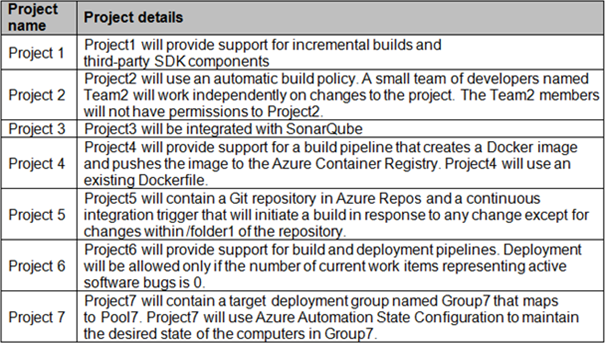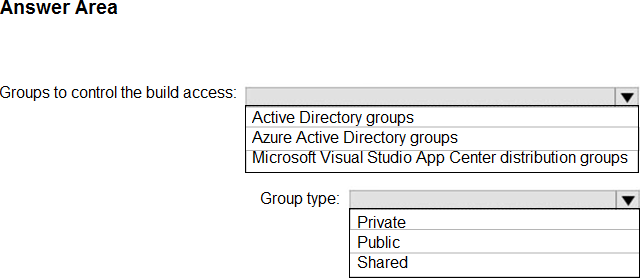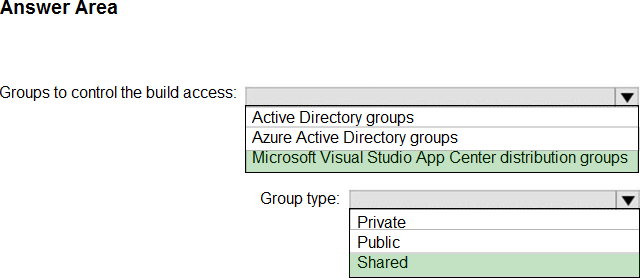Practice Free AZ-400 Exam Online Questions
You use Azure SQL Database Intelligent Insights and Azure Application Insights for monitoring.
You need to write ad-hoc queries against the monitoring data.
Which query language should you use?
- A . Kusto Query Language (KQL)
- B . PL/pgSQL
- C . PL/SQL
- D . Transact-SQL
Introductory Info
Case Study
This is a case study. Case studies are not timed separately. You can use as much exam time as you would like to complete each case. However, there may be additional case studies and sections on this exam. You must manage your time to ensure that you are able to complete all questions included on this exam in the time provided.
To answer the questions included in a case study, you will need to reference information that is provided in the case study. Case studies might contain exhibits and other resources that provide more information about the scenario that is described in the case study. Each question is independent of the other questions in this case study.
At the end of this case study, a review screen will appear. This screen allows you to review your answers and to make changes before you move to the next section of the exam. After you begin a new section, you cannot return to this section.
To start the case study
To display the first question in this case study, click the Next button. Use the buttons in the left pane to explore the content of the case study before you answer the questions. Clicking these buttons displays information such as business requirements, existing environment, and problem statements. If the case study has an All Information tab, note that the information displayed is identical to the information displayed on the subsequent tabs. When you are ready to answer a question, click the Question button to return to the question.
Overview
Contoso, Ltd. is a manufacturing company that has a main office in Chicago.
Existing Environment
Contoso plans to improve its IT development and operations processes by implementing Azure DevOps principles. Contoso has an Azure
subscription and creates an Azure DevOps organization.
The Azure DevOps organization includes:
The Docker extension
A deployment pool named Pool7 that contains 10 Azure virtual machines that run Windows Server 2019 The Azure subscription contains an Azure Automation account.
Requirements
Planned changes
Contoso plans to create projects in Azure DevOps as shown in the following table.

Technical requirements
Contoso identifies the following technical requirements:
Implement build agents for Project1.
Whenever possible, use Azure resources.
Avoid using deprecated technologies.
Implement a code ow strategy for Project2 that will:
– Enable Team2 to submit pull requests for Project2.
– Enable Team2 to work independently on changes to a copy of Project2.
– Ensure that any intermediary changes performed by Team2 on a copy of Project2 will be subject to the same restrictions as the ones defined in the build policy of Project2.
Whenever possible, implement automation and minimize administrative effort. Implement Project3, Project5, Project6, and Project7 based on the planned changes.
Implement Project4 and configure the project to push Docker images to Azure Container Registry.
In Azure DevOps, you create Project3.
You need to meet the requirements of the project.
What should you do first?
- A . From Azure DevOps, modify the build definition.
- B . From SonarQube, obtain an authentication token.
- C . From Azure DevOps, create a service endpoint.
- D . From SonarQube, create a project.
HOTSPOT
Your company is creating a suite of three mobile applications.
You need to control access to the application builds. The solution must be managed at the organization level.
What should you use? To answer, select the appropriate options in the answer area. NOTE: Each correct selection is worth one point.


Explanation:
Box 1: Microsoft Visual Studio App Center distribution Groups
Distribution Groups are used to control access to releases. A Distribution Group represents a set of users that can be managed jointly and can have common access to releases. Example of Distribution Groups can be teams of users, like the QA Team or External Beta Testers or can represent stages or rings of releases, such as Staging.
Box 2: Shared
Shared distribution groups are private or public distribution groups that are shared across multiple apps in a single organization. Shared distribution groups eliminate the need to replicate distribution groups across multiple apps.
Note: With the Deploy with App Center Task in Visual Studio Team Services, you can deploy your apps from Azure DevOps (formerly known as VSTS) to App Center. By deploying to App Center, you will be able to distribute your builds to your users.
Reference: https: //docs.microsoft.com/en-us/appcenter/distribution/groups
Your company is building a new solution in Java.
The company currently uses a SonarQube server to analyze the code of .NET solutions.
You need to analyze and monitor the code quality of the Java solution.
Which task types should you add to the build pipeline?
- A . Grunt
- B . Octopus
- C . Maven
- D . Gulp
DRAG DROP
You plan to use Azure DevOps in development processes.
You identify the following issues with the existing development processes:
• Frequent discovery of bugs in production
• Increasing detection of bugs by customers
• Slow resolution of bugs and slow resumption of production
You need to implement Key Performance Indicators (KPIs) to track each issue.
Which KPI should you implement for each issue? To answer, drag the appropriate KPIs to the correct issues. Each KPI may be used once, more than once, or not at all. You may need to drag the split bar between panes or scroll to view content. NOTE: Each correct selection is worth one point.


Note: This question is part of a series of questions that present the same scenario. Each question in the series contains a unique solution that might meet the stated goals. Some question sets might have more than one correct solution, while others might not have a correct solution.
After you answer a question in this section, you will NOT be able to return to it. As a result, these questions will not appear in the review screen.
Your company has a project in Azure DevOps for a new web application.
You need to ensure that when code is checked in, a build runs automatically.
Solution: From the Triggers tab of the build pipeline, you select Batch changes while a build is in progress.
Does this meet the goal?
- A . Yes
- B . No
You are developing an application. The application source has multiple branches.
You make several changes to a branch used for experimentation.
You need to update the main branch to capture the changes made to the experimentation branch and override the history of the Git repository.
Which Git option should you use?
- A . Rebase
- B . Fetch
- C . Merge
- D . Push
You are developing an application. The application source has multiple branches.
You make several changes to a branch used for experimentation.
You need to update the main branch to capture the changes made to the experimentation branch and override the history of the Git repository.
Which Git option should you use?
- A . Rebase
- B . Fetch
- C . Merge
- D . Push
Introductory Info
Case Study
This is a case study. Case studies are not timed separately. You can use as much exam time as you would like to complete each case. However, there may be additional case studies and sections on this exam. You must manage your time to ensure that you are able to complete all questions included on this exam in the time provided.
To answer the questions included in a case study, you will need to reference information that is provided in the case study. Case studies might contain exhibits and other resources that provide more information about the scenario that is described in the case study. Each question is independent of the other questions in this case study.
At the end of this case study, a review screen will appear. This screen allows you to review your answers and to make changes before you move to the next section of the exam. After you begin a new section, you cannot return to this section.
To start the case study
To display the first question in this case study, click the Next button. Use the buttons in the left pane to explore the content of the case study before you answer the questions. Clicking these buttons displays information such as business requirements, existing environment, and problem statements. If the case study has an All Information tab, note that the information displayed is identical to the information displayed on the subsequent tabs. When you are ready to answer a question, click the Question button to return to the question.
Overview
Contoso, Ltd. is a manufacturing company that has a main office in Chicago.
Existing Environment
Contoso plans to improve its IT development and operations processes by implementing Azure DevOps principles. Contoso has an Azure subscription and creates an Azure DevOps organization.
The Azure DevOps organization includes:
The Docker extension
A deployment pool named Pool7 that contains 10 Azure virtual machines that run Windows Server 2019 The Azure subscription contains an Azure Automation account.
Requirements
Planned changes
Contoso plans to create projects in Azure DevOps as shown in the following table.

Technical requirements –
Contoso identifies the following technical requirements:
Implement build agents for Project1.
Whenever possible, use Azure resources.
Avoid using deprecated technologies.
Implement a code ow strategy for Project2 that will:
– Enable Team2 to submit pull requests for Project2.
– Enable Team2 to work independently on changes to a copy of Project2.
– Ensure that any intermediary changes performed by Team2 on a copy of Project2 will be subject to the same restrictions as the ones defined in the build policy of Project2.
Whenever possible, implement automation and minimize administrative effort. Implement Project3, Project5, Project6, and Project7 based on the planned changes.
Implement Project4 and configure the project to push Docker images to Azure Container Registry.
You need to implement Project4.
What should you do first?
- A . Add the FROM instruction in the Docker le le.
- B . Add a Copy and Publish Build Artifacts task to the build pipeline.
- C . Add a Docker task to the build pipeline.
- D . Add the MAINTAINER instruction in the Docker le le.
You plan to create a GitHub work ow that will use GitHub Actions. The actions will require a 256-KB secret.
You need to recommend a solution to store and encrypt the secret. The secret value must be accessible only to the work ow. The solution must minimize administrative effort
What should you recommend?
- A . Store the secret in the organization-level GitHub secrets.
- B . Store the secret in the repository-level GitHub secrets.
- C . Encrypt the secret value and store the value in the repository. Store the decryption key in the repository-level GitHub secrets.
- D . Encrypt the secret value and store the value in the repository. Store the decryption key in the organization-level GitHub secrets.
